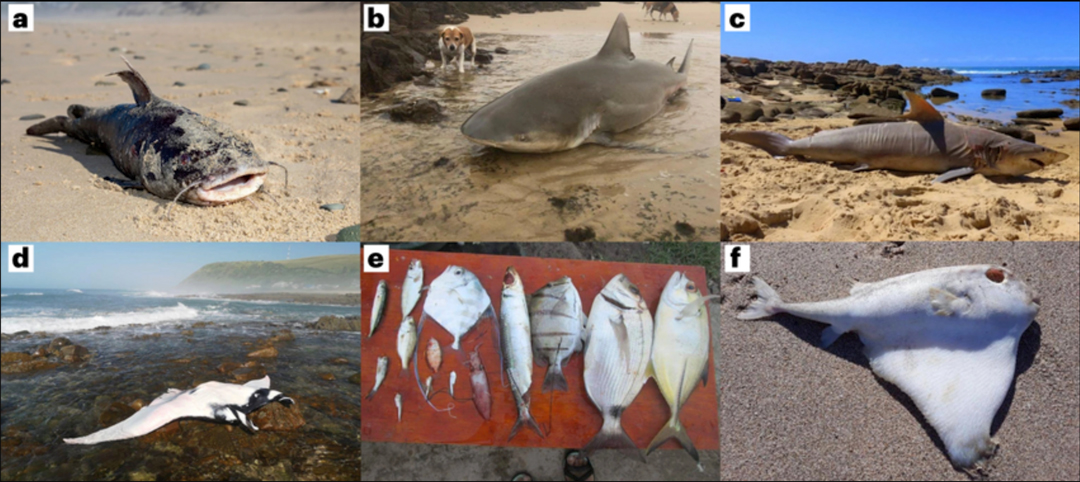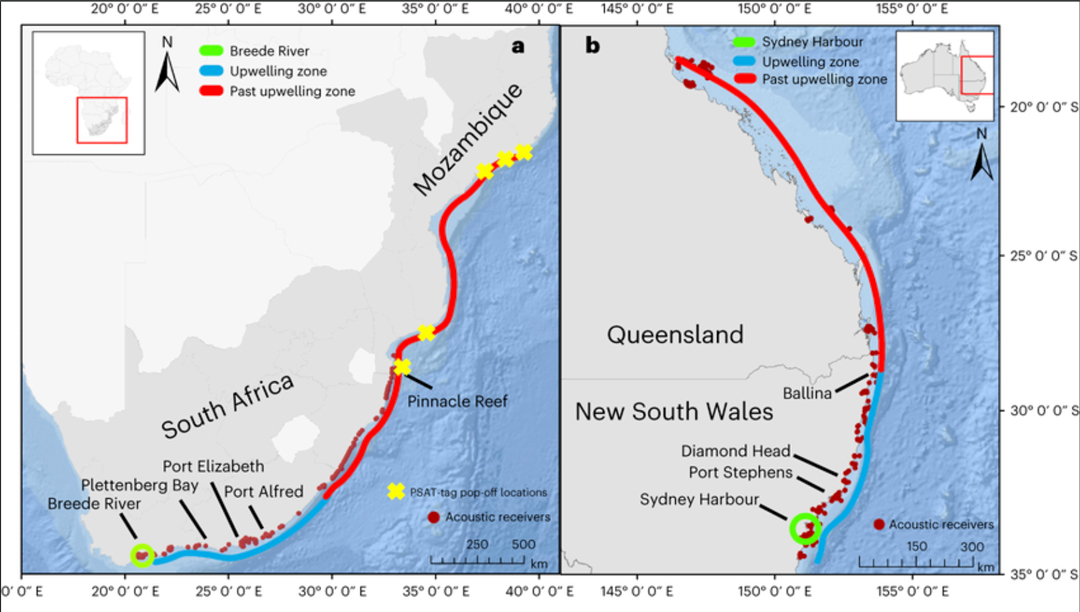Cool summer seas are a climate-linked killer
The surprising science of extreme upwelling events
It’s summer in the southern hemisphere and the happy beaches of South Africa’s Eastern Cape province – usually awash with merrymaking tourists and locals squeezing the last salty drops from a sun-drenched season – are the site of bewildering carnage. A mobulid ray lies belly-up on a rocky shore, its wings spread drying in the sun. A lifeless bull shark is so perfectly beached, it seems still to be swimming its way up the sandy shoreline.
Scientists scramble to document the life washing ashore as a cold upwelling spell sends ocean temperatures on a downward spiral of more than 7˚C in less than 48 hours. Their list grows to include blacktip sharks and bigeye trevally fish, lobsters, octopus and grouper fish. The death toll is shocking. In the end, no fewer than 260 marine animals from 81 different species wash up on beaches between Gqeberha (formerly Port Elizabeth) and East London. More than 75% of the species killed are at the poleward limit of their distribution; they simply can’t move into colder waters to escape changing sea temperatures, so surprising extreme events like this cause mass die-offs.

Marine taxa killed during the killer upwelling event in March 2021 A selection of the fish and elasmobranch carcasses that washed up during an intense upwelling event between 2 and 7 March 2021 on local beaches between Port Elizabeth and north of East London. a, Galeichthys sp. b, Caracharhinus leucas. c, Carcharhinus sp. d, Mobula sp. e, Selection of cephalopods and teleost, including Caranx sexfasciatus. f, Triodon macropterus.
The details of what happened in March 2021 are found in a paper published this year in Nature Climate Change. Nicolas Lubitz, a Save Our Seas Foundation project leader and a PhD candidate, together with a host of co-authors, penned ‘Climate change-driven cooling can kill marine megafauna at their distributional limits’. Their postmortem of the event is that waters were warm across the continental shelf around 28 February 2021, but an unexpectedly cold and intense upwelling cell was developing off the coast of Port Alfred, a popular seaside holiday spot on the mouth of the Kowie River, almost halfway between Gqeberha and East London. Four days of easterly winds, combined with a cyclonic eddy moving south, created ideal conditions for upwelling to occur. And then, all of a sudden, temperatures off Port Alfred dropped a catastrophic 9.2 °C in 24 hours (from 21°C to 11.8 °C). By 1 March 2021, cold waters were at the sea’s surface stretching 230 kilometres (143 miles) across the region. Typically, upwelling events here last about three days; in 2021, the cold snap persisted for more than a week.

Seasonal movements of bull sharks in southern Africa and eastern Australia based on acoustic detections a, Map of southern Africa showing the extent of the upwelling zone and the location of Breede River within it, as well as the extent of the area bull sharks utilized past the upwelling zone. b, Map of eastern Australia showing the extent of the upwelling zone and the location of Sydney Harbour within it, as well as the extent of the area bull sharks utilized past the upwelling zone.
What is upwelling?
When wind blows across the ocean’s surface and pushes the waters here away (usually offshore, away from the continent and coastline), cold, typically nutrient-rich waters rise from the depths inshore to replace them. On the sea floor, nutrients from sediments accumulate over time because there is no light at these depths (the euphotic, or ‘no-light’, zone) for plants to photosynthesise and use them. Upwelling creates highly fertile conditions in which plankton bloom in abundance and seaweeds flourish because these nutrients are pushed to the surface by cold, deep, upwelled water. The rich pickings attract fish, marine mammals and seabirds and create the world’s most valuable fishing grounds, typically found off the western margins of continents along the coastlines of countries like Peru, Chile and South Africa.
The oceans around South Africa’s coasts are ones of contrast. Wind-driven upwelling creates conditions to support the country’s major fisheries on the west coast, where the cold Benguela Current creates the eastern boundary of the South Atlantic gyre. It is hemmed in on either side by warm currents. The great Agulhas Current is a western boundary current that pulses down the western margin of the Indian Ocean basin and along South Africa’s warm, wet, east coast. In this current regime, kinematic upwelling is driven by a regular (but not permanent) meandering in the current called the Natal Pulse, which breaks off to become cyclonic ocean eddies. Water in the centre of an eddy is cooler than at its edges, and the sea surface is also lower here. Cold, nutrient-rich waters are drawn from the deep into this centre and plankton bloom. It’s this combination of wind-and-current-driven upwelling that is typical of the coast between Gqeberha and East London.
Photo © Matthew During
Will climate change affect upwhelling?
Our changing climate is changing our oceans, and as sea surface temperatures rise and patterns of circulation shift, so too will the distribution and movement patterns of animals across the planet. Much has been said and written about tropical species moving poleward to escape rising temperatures, often displacing temperate species in the process. Much less is known about how intermittent extreme events will affect marine biodiversity. Marine heatwaves are increasingly frequent and intense, with particularly dire consequences for corals. But we know almost nothing about climate change-related cold snaps and their impact on marine life.
When temperatures change, so too do pressure systems and ocean currents, and scientists believe that upwelling cells around the planet are intensifying as a result. How does this all link together? Well, according to Nicolas and his co-authors, the concern is that while average temperatures are rising across the oceans, species are moving polewards in response and are often being pushed to the edge of their distribution limit. This means that they are being pushed to latitudes where they are at the limit of their thermal tolerance; they can’t go further north or south and won’t cope if temperatures drop. And temperatures do drop. These occasional extreme events may become more frequent if upwelling is intensifying. The scientists call this a ‘bait and switch’ scenario: animals are pushed to where they can better survive, but are caught out when an extreme upwelling event occurs and temperatures drop below optimum.
Nicolas analysed satellite sea surface temperature data from 1981 to 2022 and showed that cold events have indeed increased in frequency and intensity over 20 years. They looked at upwelling cells in the Agulhas Current, as well as the East Australian Current (another western boundary current) and because currents and eddies are the drivers of upwelling here, they suggest that upwelling is amplified during summer in the southern hemisphere, when current pulses show increased meandering and eddy kinetic energy is at its highest.
How did an extreme cold event cause a mass marine die-off?
Nicolas and his colleagues give us a first indication of how mass die-offs might play out in future as upwelling intensifies and animals move across the oceans in response to average global temperatures continuing to rise.
The events of March 2021are linked to how rapidly the temperature dropped and the intensity of the upwelling event. The results for marine life are hypothermia and death, even for big animals that can move quickly across different environments. For Nicolas and his colleagues, the concern is that the climate projections of intense extreme upwelling events that are more frequent could also increase these kinds of shocks and die-offs.
Photo © Christopher Vaughan-Jones
Will climate change affect sharks and rays?
To look at how this will affect sharks that can migrate and are likely to be moving poleward as their tropical and subtropical core range areas continue to warm, Nicolas and his colleagues used data from tagged bull sharks in southern Africa and eastern Australia. These sharks occur worldwide in tropical, subtropical and warm-temperate oceans. They are also highly mobile and migrate huge distances, but they appear to move out of a region when temperatures drop below 19˚C.
From their analysis, it appears that cold upwelling events change how bull sharks migrate and dive through the water column. They actively avoid temperatures lower than 19˚C and swim closer to the sea’s surface when they move through upwelling zones, especially when they encounter upwelling cells. Bull sharks were tracked diving deeper in tropical and subtropical waters where there were no upwelling cells.
It seems, then, that bull sharks change their behaviour to avoid cold water below their thermal tolerance. By moving quickly through upwelling zones, and keeping to shallow waters and sheltering in estuaries and bays, bull sharks appear to try to avoid and survive temperature shocks. There are other species that share the distribution and range of bull sharks; manta rays, whale sharks, common blacktip sharks and bigeye trevally fish are also migratory and may be operating at the very limit of their thermal tolerance when they move through these western boundary current upwelling zones.
If bull sharks are anything to gauge by, many animals might have strategies to try to survive cold shocks. These same species are likely to be the same ones moving poleward as their tropical and subtropical core range area increases in temperature. But the increasing intensity and frequency of these events in the light of climate change will put them at risk from extreme temperature shocks and make them highly vulnerable to these cold-induced die-offs.
The consequences of climate change for the oceans are complex and we are only beginning to glimpse potential new challenges. The general increase in sea surface temperatures across the oceans has been well documented and species are moving towards the poles. How we manage and protect these animals wherever they are in the oceans, giving them the best chance to move and survive extreme or shock events, will determine some of our future success at staving off the worst climate-related catastrophes.
**Reference:
Lubitz N, Daly R, Smoothey AF et al. 2024. Climate change-driven cooling can kill marine megafauna at their distributional limits. Nature Climate Change 14: 526–535. https://doi.org/10.1038/s41558-024-01966-8.
